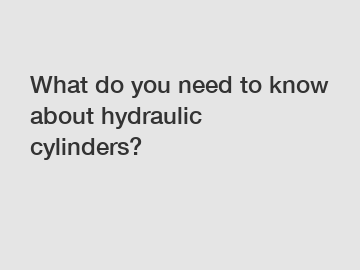Dec. 13, 2023
Machinery
When it comes to heavy machinery and industrial operations, hydraulic cylinders play a crucial role in ensuring smooth functioning and efficient power transmission. These devices are widely used in various sectors, ranging from construction and agriculture to automotive and manufacturing. Having a clear understanding of hydraulic cylinders is essential for anyone working with or relying on these powerful pieces of engineering. In this blog, we will uncover the key aspects of hydraulic cylinders, empowering you with the knowledge necessary to appreciate their significance and maximize their potential.
1. The Basics of Hydraulic Cylinders:
At its core, a hydraulic cylinder is a mechanical actuator designed to generate unidirectional force through a unidirectional stroke. It consists of a cylindrical barrel, a piston, piston rod, and various seals. These components work together, utilizing a pressurized hydraulic fluid to convert energy into linear motion. By harnessing the principles of Pascal's Law, hydraulic cylinders are able to generate substantial forces, ensuring efficient movement and operation of heavy equipment.

2. Types of Hydraulic Cylinders:
There are several types of hydraulic cylinders available, each with its own design and application. The most common types include the tie-rod cylinder, welded rod cylinder, telescopic cylinder, and mill type cylinder. Each cylinder type has specific benefits and limitations, making it essential to choose the right one based on the requirements of the intended application.
3. The Working Principle:
To better grasp how a hydraulic cylinder operates, envision a syringe filled with fluid, where the piston is pushed or pulled to create movement. Similarly, in a hydraulic cylinder, the piston moves within the cylinder barrel due to the pressure exerted by the hydraulic fluid. By controlling the fluid pressure and flow, the stroke length and force exerted by the cylinder can be manipulated, leading to precise and controlled movements.
4. Applications of Hydraulic Cylinders:
Hydraulic cylinders are widely employed across industries for a multitude of applications. From heavy machinery in construction and mining to agricultural equipment, hydraulic cylinders play an integral role in raising, lowering, pushing, and pulling heavy loads. They are also utilized in manufacturing processes, material handling, vehicle brakes, robotic systems, and even aircraft.
5. Maintenance and Troubleshooting:
Ensuring the longevity and optimal performance of hydraulic cylinders requires regular maintenance. Periodic inspections, sealing checks, and monitoring fluid levels are essential. Timely replacement of worn-out seals, thorough cleaning, and replenishing hydraulic fluid are critical to prevent damage. When it comes to troubleshooting, common issues such as leakage, slow operation, and jerky movements can often be traced back to seal problems or insufficient fluid levels.
6. Safety Considerations:
Working with hydraulic systems involves potential hazards. Hydraulic cylinders operate under significant pressures, and any mishap can result in severe injuries or equipment damage. Following safety protocols, adhering to manufacturer guidelines, and using appropriate Personal Protective Equipment (PPE) are imperative when interacting with hydraulic cylinders. Regular training and awareness regarding safe practices can go a long way in minimizing risks.
7. Advancements in Hydraulic Cylinder Technology:
As technology advances, hydraulic cylinder designs continue to evolve. Advanced materials, improved sealing techniques, and enhanced precision have led to more efficient and reliable cylinder systems. Additionally, the development of smart cylinders equipped with sensors and monitoring capabilities has revolutionized the predictive maintenance and operational efficiency of hydraulic systems.
Conclusion:
Understanding hydraulic cylinders is crucial for safe and efficient industrial operations. These powerful devices, with their ability to generate substantial forces, enable the smooth functioning of heavy machinery across various sectors. By delving into the basics, types, working principles, applications, and maintenance aspects, we hope to have provided you with valuable insights into the world of hydraulic cylinders. Remember, the safe and effective utilization of hydraulic cylinders requires ongoing learning, attentiveness, and adherence to industry standards.
For more customized dual action cylinder solution, SRB Machine Supplier in China, CNC Skiving Roller Burnishing Machine Supplier in Chinainformation, please contact us. We will provide professional answers.
If you are interested in sending in a Guest Blogger Submission,welcome to write for us!
All Comments ( 0 )